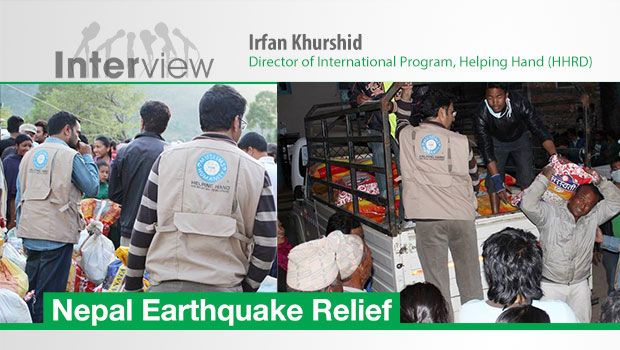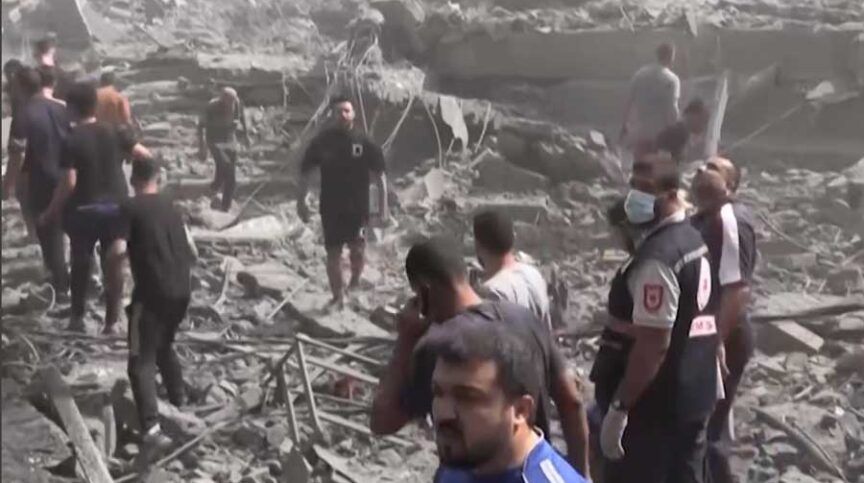May, 18, 2015 from Kathmandu Nepal
Br. Irfan Khurshid is currently working as a Senior Advisor for International Affairs, Programs & Disaster Management with Helping Hand Relief and Development (HHRD), a Detroit-based international Muslim charitable organization. He has been associated with HHRD since day onein 2005, serving as its first executive director. His work with relief programs, however, began about 16 years ago in 1998-1999 with ICNA Relief. A civil and environmental engineer by profession, he began his work with social programs when he was a student. Since then, his passion for helping the needy has continued and kept him active and motivated through his work at Helping Hand.
Br. Irfan Khurshid and his team traveled to Nepal for relief efforts immediately after the disastrous earthquake in April. They have been there since, providing immediate as well as long-term relief for the victims. We had the opportunity to speak to him from his base in Nepal about his current efforts and eyewitness accounts of the situation there.
- In your relief work you have seen so much devastation from natural disasters across the world. What was your reaction to this one when you first arrived in Nepal and witnessed the damage and devastation? What was the severity of destruction and number of people affected by the Nepal earthquake compared to other disasters?
IK:The most striking detail that comes to my mind is that there were two side-by-side severe earthquakes (in terms of magnitude) just weeks apart, followed by series of aftershocks which was a serious event for this small and poor but proud Himalayan nation. There were close to 10,000 deaths, and as much or more in injuries, and close to half a million homes completely destroyed or partially damaged and not in any condition to return to.
Human loss was comparatively less compared to the same magnitude earthquake in the same kind of populated areas because both major earthquakes occurred during the day when most of the people were out of their homes, but property damage was extensive. Because of the series of earthquakes and the big aftershocks, public confidence was shaken and everyone was scared to go inside their homes.
- Nepal is known to be a region prone to natural hazards such as flooding, severe thunderstorms, and landslides. With this type of history, were any of the hard hit areas prepared to counteract the devastation? Was there infrastructure built to with stand the force of earthquakes or any programs that teach the people strategies to minimize injuries and destruction during these natural hazards?
IK:Nepal has a history of devastating earthquakes almost every 100 years. The last one was in 1934 and before that 1833. People were not prepared as most of the casualties resulted from collapsing houses and slides. Most of the houses that were damaged were very old, simple brick and mortar type of construction which are not capable of withstanding an earthquake, especially of this magnitude.
- What has been the response from Nepal’s government and from the locals to HHRD’s rescue and assistance efforts? Were they cooperative and helpful or did you encounter obstacles when trying to implement your relief programs?
IK: The people of Nepal are very humble and patient. The government was also very supportive of our efforts and greatly appreciated HHRD’s help and intervention in this aftermath. Some members of the Parliament helped by joining our distribution programs. Fortunately we did not face any major issues during any of our operations including distributions, daily clinics, or implementing any other of our relief programs.
- Have HHRD team members been put at risk while assisting with rescue and relief efforts in Nepal such as when the second earthquake struck within weeks of the first one in April? If so, what was the experience like and how did it hinder or setback your relief work in the region?
IK: Working in any disaster area, particularly in earthquake zones, is always risky. It is very hard to predict when an earthquake will strike. Safety of HHRD’s team and volunteers is one of our top priorities. While in Nepal, HHRD’s team and volunteers had to face many big aftershocks and the second major big earthquake hit the 12th of May. It was inarguably a very scary experience. To put it visually, everyone was running, buildings were falling and dust was flying everywhere. Children and adults could be heard crying. But, alhamdulillah, all of our team members were safe.
- What is the current morale among the people of Nepal? Are they feeling hopeless and immobile? Or are they finding a renewed sense of determination to overcome this disaster? I ask this because sometimes these disasters end up creating lawlessness and anarchy rather than unity and mutual assistance.
IK: People of Nepal are very hardworking, polite, and content. I did not witness any violence. In any distribution run, if there were more needy people than the availability of relief items, anyone who did not receive the supplies did not complain.After the second earthquake hit, however, people were even more frightened, feeling helpless and scared to go back inside their homes to retrieve any necessary items. One of the senior doctors mentioned that even some of the medical staff had lost confidence. Lots of people spent their nights sleeping outside.
- What is the most critical assistance currently needed? Is it in rebuilding, medical assistance, or food supplies, or something else? In an appeal to the public, how best can they help?
IK: People’s homes and livelihood have essentially been destroyed. They need every type of help they can get.But to prioritize, the most needed are shelters and homes and good quality family tents. Monsoon season is expected around mid-June and currently most of the people are without any reliable shelters or tents. In addition, food, medicine, clothes, blankets, mosquito nets, and hygiene kits are the top required items.
We are also looking into the possibilities of starting some programs, namely the Orphans Support Program (OSP), Skills Development Centers (SDC), Interest Free Micro Finance Program (ESSAR), and Mother & Child Health Centers (MCHC).Any and all assistance in these areas from the public will always be appreciated and put to good use.
- Does HHRD have enough team members to accomplish its goals?
IK: HHRD team has trained emergency staff, doctors, and volunteers working to maximum output. Basically everyone was working around the clock and luckily we were able to enlist many local volunteers for help. I will also add that the youth wereparticularly important in helping us to carry out our work.
Have the current weather conditions in Nepal been favorable to your work? Has rain or excessive heat hindered the relief efforts?
IK: Generally, the weather has been good but there were many days that we got heavy rain which made the lives of the affected people more miserable and distribution activities difficult.
What are your thoughts after seeing the situation that you would like to share with the public?
IK: This small underdeveloped nation is suffering badly. The government has very limited resources. The people are good, hardworking, and proud. With enough planned help from the governments, NGOs, and donors, we may be able to help them get back on their feet once again and resume their normal daily lives.
- 10. What would be your suggestions for people, governments, and the international community about preparedness and natural disaster management?
IK: Be prepared for disasters before they strike. Most of the people killed in earthquakes are due to falling buildings and houses. The local, state, and federal governments should have strict regulations in place for new construction, as well as inspecting the infrastructure of older homes and buildings to ensure they are fit and capable to withstand earthquakes.
Disaster plans should be in place and emergency response teams should be prepared for action in case disaster strikes. Trained rescue teams, equipment, search and rescue dogs, and preparedness education of the public should be in place to avoid as many injuries and as much damage as possible. There is great value and benefit for everyone in this preparation.





